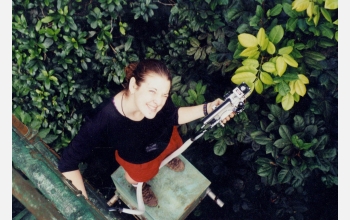News Release 05-139
Scientists Climb Trees to Study Environmental Change
View From Tree Canopy Provides New Look at Forest Ecosystem
August 15, 2005
This material is available primarily for archival purposes. Telephone numbers or other contact information may be out of date; please see current contact information at media contacts.
Dangling from a handy branch in her technical rock-climbing gear, ecologist Nancy Harris of the State University of New York at Syracuse is demonstrating a new way to study one of the richest and least-understood regions of the tropical rain forest: the treetop canopy.
Thus the appeal of Harris' rock-climbing method, which gives her access to virtually any tree in a forest, regardless of topography.
Working in Puerto Rico's Luquillo Forest, one of NSF's 26 LTER sites, she and her colleagues can rig a tree for climbing in as little as an hour. A giant slingshot is used to shoot a three-ounce fishing weight, attached to a 12-pound-test fishing line, over a branch high in the canopy. Once the line is over the branch, it is replaced first with parachute cord and then with a 12-millimeter-diameter rock-climbing rope that can be climbed using a harness and mechanical ascenders. A separate pulley system is rigged so instruments can be raised or lowered to any height in the canopy by pulling a rope from the ground.
Once she ascends, Harris uses a portable device to measure the photosynthetic rates of both canopy and understory leaves of different tree species. She will later combine these measurements with climate modeling techniques to figure out how the element carbon flows through specific "columns" of the Luquillo Forest. Carbon is important in studies of global climate change.
Other researchers at the Luquillo LTER site are climbing trees to find out how much damage hurricanes wreak on rain forest canopies. To match the damage observed after past hurricanes, scientists have removed specific numbers of tree branches from experimental plots.
Tree canopies are important regulators of local environmental conditions because of their exposure and the resistance they provide to wind damage, said Gholz. "But canopies are also very susceptible to the high winds of strong storms like hurricanes."
Hurricanes like Hugo regularly strike Puerto Rico, said scientist Nick Brokaw of the University of Puerto Rico, cutting a swath through the forest. "However, in our experimental plots mimicking hurricane conditions, we're seeing that thousands of new seedlings are sprouting, and thickets of saplings are developing."
If the forest could regenerate after Hugo, Brokaw believes, it can come back after almost anything.
-NSF-
Media Contacts
Cheryl L. Dybas, NSF, (703) 292-7734, email: cdybas@nsf.gov
Related Websites
Luquillo Experimental Forest: http://luq.lternet.edu/
The Long-Term Ecological Research Network: http://www.lternet.edu/
The U.S. National Science Foundation propels the nation forward by advancing fundamental research in all fields of science and engineering. NSF supports research and people by providing facilities, instruments and funding to support their ingenuity and sustain the U.S. as a global leader in research and innovation. With a fiscal year 2023 budget of $9.5 billion, NSF funds reach all 50 states through grants to nearly 2,000 colleges, universities and institutions. Each year, NSF receives more than 40,000 competitive proposals and makes about 11,000 new awards. Those awards include support for cooperative research with industry, Arctic and Antarctic research and operations, and U.S. participation in international scientific efforts.
Connect with us online
NSF website: nsf.gov
NSF News: nsf.gov/news
For News Media: nsf.gov/news/newsroom
Statistics: nsf.gov/statistics/
Awards database: nsf.gov/awardsearch/
Follow us on social
Twitter: twitter.com/NSF
Facebook: facebook.com/US.NSF
Instagram: instagram.com/nsfgov



